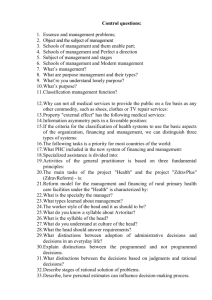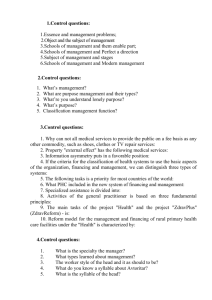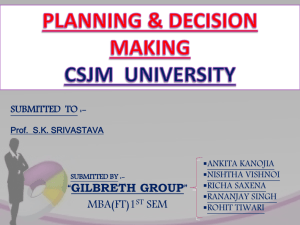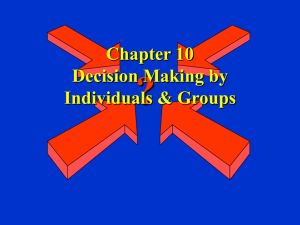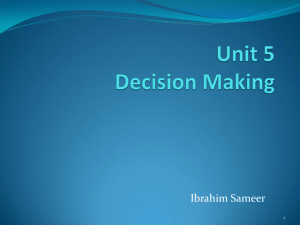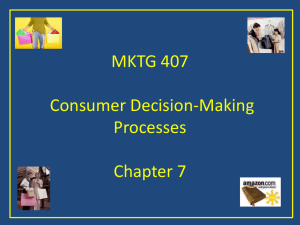FOUNDATIONS OF DECISION MAKING
advertisement
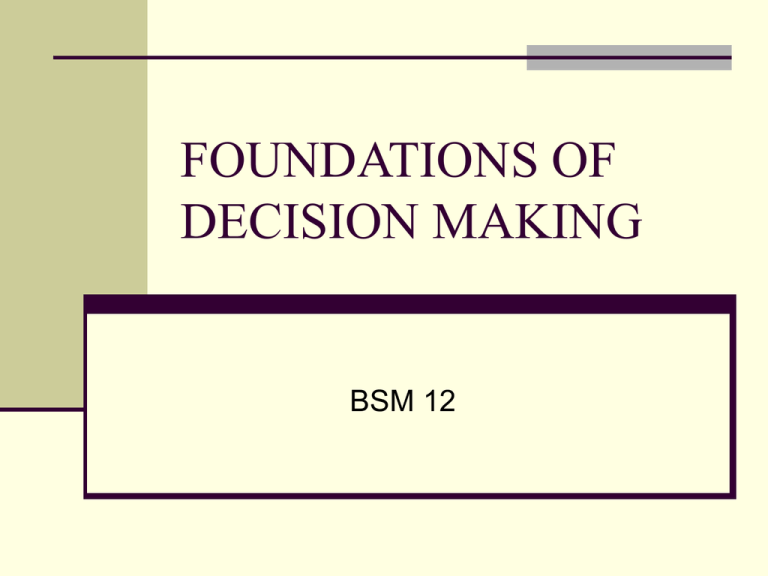
FOUNDATIONS OF DECISION MAKING BSM 12 Planning involves decision-making Analyzing alternatives and choosing the best one Examples of planning function decisions: What are the organization’s long and short- term objectives? What strategies will best achieve these objectives? What is the most efficient means of completing tasks? What budgets are needed to complete tasks? The Decision-Making Process STEPS 1. 2. 3. Identify the problem— compare existing state with desired state Choose criteria or factors that are relevant in the decision Prioritize criteria EXAMPLE 1. Car doesn’t work or needs to be replaced 2. Manufacturer, price, model, options, repair records, fuel efficiency, etc. 3. Price, fuel, options The Decision-Making Process 4. List alternatives that could resolve the problem Analyze the alternatives— strengths and weaknesses—against the criteria 6. Choose the best alternative 5. Identify vehicle choices: Toyota Camry, Honda Accord, Chev Malibu 5. Compare vehicles against criteria—test drive, read reports 4. 6. Toyota Camry The Decision-Making Process Implement the decision—put into action; communicate with those affected and get their commitment 8. Evaluate the effectiveness of the decision to see if the problem has been corrected 7. 7. Purchase the selected vehicle 8. Drive vehicle and determine whether it satisfies needs TYPES OF PROBLEMS problems may be straightforward, familiar and easily defined or well-structured example: a supplier is late with an important delivery OR ill-structured—new or unusual problems where information is incomplete or ambiguous example: a decision to purchase a new technology TYPES OF DECISIONS 1. programmed decisions: a repetitive decision handled by a routine approach and based on previous solutions Example: If a mechanic breaks something during repair service the part is replaced at the company’s expense continue How do managers make programmed decisions? They use guidelines: a. procedures – a series of steps a manager can use when responding to a well-structured problem. Decisionmaking is carrying out simple series of sequential steps. example How do managers make programmed decisions? Guidelines • rule – an explicit (clear) statement that tells a manager what he should or should not do. Example: the $7500 cut-off rule simplifies the manager’s decision about getting bids. • policy – a general guide to channel a manager’s thinking in a specific direction. Ethical standards come into play when following a policy. Example: “we promote from within” Example A request to purchase software for computers has been received. Procedure: fill in requisition and approval cost is estimated if total is over $7500, 3 bids must be obtained if total is less than $7500, a vendor is chosen and the order placed TYPES OF DECISIONS 2. non-programmed decisions: decisions that must be custom-made to solve unique and non-recurring problems; there is no cut-anddried solution. Example: creating a new organizational strategy involves a different set of environmental factors and other conditions may have changed How do you integrate problems, types of decisions, and level in the organization? Well-structured problems are responded to with programmed decision making Ill-structured problems require non-programmed decision making Lower level managers usually face familiar and repetitive problems and rely on procedures Higher level managers usually deal with unique decisions Top management creates the policies, procedures and rules to guide other managers in their decision making How do you integrate problems, types of decisions, and level in the organization? TOP ILL STRUCTURED NONPROGRAMMED DECISIONS LEVEL TYPE OF IN PROBLEM ORGANIZATION PROGRAMMED DECISIONS WELL STRUCTURED LOWER DECISION-MAKING STYLES Individuals differ in: 1. the way they think a. b. logical, rational, sequential or creative, intuitive, “big picture” AND 2. tolerance of ambiguity (uncertainty) a. b. high need for consistency—no ambiguity or high levels of ambiguity—can process many thoughts at once DECISION-MAKING STYLES There are four decision-making styles, although managers will possess characteristics of more than one. 1. directive 2. analytic 3. conceptual 4. behavioural STYLE THINKING AMBIGUITY CHARACTERISTICS 1. DIRECTIVE RATIONAL LOW logical, efficient, fast decisions, focused on short term 2. ANALYTIC RATIONAL HIGH prefers to have complete information, considers many alternatives 3. CONCEPTUAL CREATIVE HIGH very broad in outlook, looks at many alternatives, focuses on long run and creative solutions 4. BEHAVIOURAL CREATIVE LOW works well with others, open to suggestions, concerned about those who work with them Tolerance for Ambiguity HIGH LOW ANALYTIC CONCEPTUAL DIRECTIVE BEHAVIOURAL RATIONAL INTUITIVE WAY OF THINKING GROUP DECISION-MAKING Individual and group decisions have their own set of strengths. Neither is ideal for all situations. Advantages of Group Decision-Making provide more complete information than individual ones — “two heads are better than one” a group brings diversity of experience and perspectives to the process and will come up with more alternatives increases the likelihood that the solution will be accepted by all those concerned makes decisions more legitimate and democratic Disadvantages of Group Decision-making more time-consuming to organize and reach a solution a few members may have an undue influence on final decision pressures to conform may result in groupthink—the withholding by group members of different views in order to appear to be in agreement When are groups most effective? This depends on criteria: on average groups make better, more accurate decisions than individuals groups are more creative but slower higher degree of acceptance of solutions size influences effectiveness: larger is more heterogeneous larger means more coordination and time and therefore may be less efficient minimum of five to maximum of 15 is best having odd numbers prevents deadlocks

